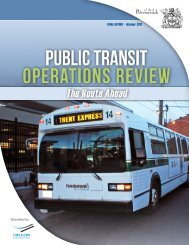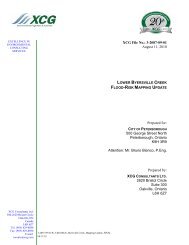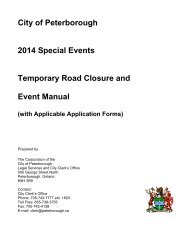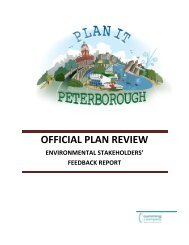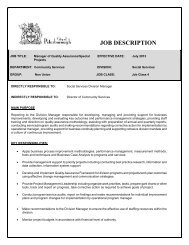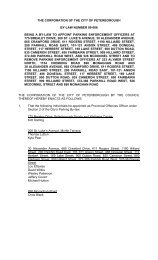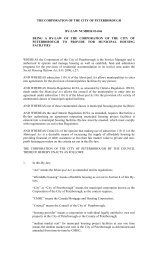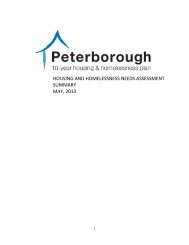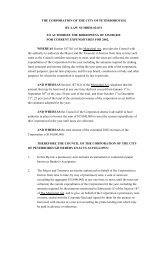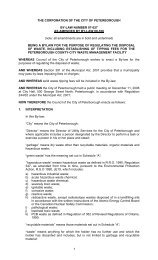Thompson Creek Flood Study Report - City of Peterborough
Thompson Creek Flood Study Report - City of Peterborough
Thompson Creek Flood Study Report - City of Peterborough
You also want an ePaper? Increase the reach of your titles
YUMPU automatically turns print PDFs into web optimized ePapers that Google loves.
<strong>Thompson</strong> <strong>Creek</strong> Detailed <strong>Flood</strong> Reduction <strong>Study</strong><br />
<strong>City</strong> <strong>of</strong> <strong>Peterborough</strong><br />
These systems will be detailed further in the section describing the OTTSWMM<br />
modelling <strong>of</strong> their major/minor system flow characteristics (Section 4.4.3).<br />
To the best <strong>of</strong> our knowledge, there are no existing stormwater management facilities<br />
within this part <strong>of</strong> the study area. However, there is low area east <strong>of</strong> Armour Road just<br />
north <strong>of</strong> Franmor Drive which may be functioning as a stormwater storage area.<br />
4.4 MODELLING CHARACTERISTICS OF MAJOR/MINOR SYSTEMS<br />
As noted above, three different computer modelling tools were used to complete the<br />
analysis <strong>of</strong> existing flood vulnerability. The following sections describe first the<br />
analysis <strong>of</strong> water course related flood vulnerability then local flood vulnerability.<br />
4.4.1 OTTHYMO Modelling <strong>of</strong> <strong>Thompson</strong> <strong>Creek</strong> Drainage Area<br />
The first step in analysing vulnerability to flooding from the <strong>Thompson</strong> <strong>Creek</strong><br />
watercourse was to estimate the flows carried by the creek under various rainfall events.<br />
To do this, the Visual OTTHYMO computer model was used. It transforms rainfall<br />
data into flow estimates using equations which represent the response <strong>of</strong> the watershed.<br />
The response is represented by parameters such as the drainage area, watershed slope,<br />
watershed length, soil characteristics, imperviousness <strong>of</strong> the surface and initial wetness<br />
<strong>of</strong> the basin. Together, these dictate how much run<strong>of</strong>f will occur for a particular rainfall<br />
and how fast that run<strong>of</strong>f will be transformed into flow in the creek. The following<br />
describes the development <strong>of</strong> the OTTHYMO model and its verification using<br />
monitored flow data.<br />
4.4.1.1 Model Development<br />
Existing Land Use<br />
The <strong>Thompson</strong> <strong>Creek</strong> watershed was subdivided into four sub-areas to facilitate<br />
modelling its response under existing land use conditions. Figure 4.4.1 shows the<br />
drainage boundaries <strong>of</strong> the sub-areas and their actual drainage areas in hectares. It also<br />
shows the locations along the creek at which flows were calculated by the model.<br />
Table 4.4.1 shows the other parameters used in the model to represent existing<br />
conditions. Documentation <strong>of</strong> the model is included in Appendix H. This model was<br />
used to estimate flows for measured rainfall/flow events monitored during the period<br />
April to June 2006 to verify that the model was a good representation <strong>of</strong> the watershed<br />
(see Section 4.4.1.2). However, it was not used to simulate the “design events” to<br />
investigate flood vulnerability since land use changes are imminent within the<br />
<strong>Thompson</strong> <strong>Creek</strong> watershed. To do so, the existing conditions model was modified to<br />
represent future land use conditions.<br />
14-06605-01-W01 <strong>City</strong> <strong>of</strong> <strong>Peterborough</strong> 45




